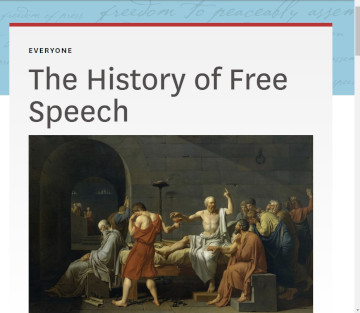The creators of the Nomadic Professor courses, Dr. William Jackson and Nate Noorlander, teamed up with FIRE (Foundation for Individual Rights and Expression) to create the one-semester The History of Free Speech course. This is a challenging, online course for students in middle school and high school that covers a great deal of historical information. I think it will be most useful for students who have already studied both U.S. and world history so they will not be overwhelmed with too much new information. The course makes connections between historical events, pulling together much of what students learn or already know in meaningful ways.
This free, online course takes a non-partisan approach and is designed to help students learn more about the history of free speech throughout the world. FIRE is an organization devoted to the promotion of free speech, so it is no surprise that the course is designed to advance the idea of free speech and to help students become more open to hearing speech that might contradict their own views and preferences. Along the way, students learn the skills of the historian—including reading from a variety of sources, weighing ideas, and re-evaluating preconceptions.
Course Organization
The course is designed like other Nomadic Professor courses with videos, reading, notetaking, primary document analysis, vocabulary work, writing assignments, and quizzes.
The course is presented in four units, with two sections in the first three units and three in the fourth unit. Pre- and post-surveys are intended to measure the course’s impact on students’ attitudes. (Students shouldn’t be discouraged by their scores on the pre-test! It provides a point of comparison at the end of the course.)
The downloadable course handbook outlines three possible tracks: basic, standard, and advanced. The tracks differ in the number of document lessons to be completed, the use of “structure-building” activities, and the use of either audio or text for much of the course content. The standard and advanced tracks provide all lesson content (aside from the videos) via articles to be read online, while the basic track has students listen to audio recordings of the lesson content. All students need to read the document lesson content if those lessons are assigned.
Guided Notes and Course Content
Students will complete “guided notes” as they read (or listen) and watch videos that present each unit’s content. The guided notes are graphic organizers downloaded as PDFs. Students can write on them by hand or by using a PDF editor. The guided notes require critical thinking and analysis rather than just filling in blanks. For example, section 4.2 asks students to complete a table comparing freedom of speech in Wilson’s and Roosevelt’s USA, Hitler’s Germany, and Lenin’s and Stalin’s Russia. Answer keys for the guided notes are included. The final lesson addresses the internet, bringing up current issues such as, “Should states be allowed to apply pressure on private corporations so that those corporations will remove content deemed undesirable by the government from their platforms? If yes, to what extent, who decides, and how can a society ensure that this power is never abused? If no, then are there no exceptions?”
Building Structures for Key Terms
Students beyond the basic level create structures with the key terms in each section, gradually building upon the original structure they create. Students show relationships between the terms through their structure, which helps them to assimilate and retain the information. As one of the videos explains, students can create their structures using any format they wish—paper and pen, whiteboard, computer file, physical objects, etc. A rubric for evaluating the structure-building activities is included in the course guide.
All students can also work on learning the key terms with online flashcards and lists of key terms and definitions.
Quizzes
Each section of the course (aside from the document lessons) has a 10-question online quiz. The quizzes always have one question that requires students to match up the key terms and definitions. Students can retake the quizzes to improve their scores.
Document Lessons
Each unit has a culminating document lesson, although students will complete only the document lessons required for their track. Each document lesson has its own graphic organizer, similar to the guided notes PDFs. Students are walked through the process of “Sourcing, contextualizing, reading and inferring, and corroborating.” They are provided with a downloadable file with a variety of sources for information on the questions, “How should we characterize the death of Socrates?”, “Was the ‘Boston Massacre’ just media propaganda?”, “Were the Sedition Acts of 1798 and 1918 the same thing?”, and “Why did Twitter suppress a story from the New York Post?” (an investigation into the Hunter Biden laptop story). The sources include primary source documents, excerpts from history books, news articles, political cartoons, and Twitter posts. Students are given leading questions to help them evaluate the sources, consider their contexts, evaluate the claims of the sources (whether explicit or not), and compare the claims of each source in relation to others.
Document lessons have a scoring rubric in the handbook, and there’s an answer key for each document lesson showing one way each graphic organizer might be completed. Students can work independently through the course, but it might be helpful to discuss and work through the document lessons with more guidance.
Summary
The History of Free Speech course is outstanding, both because it is well designed and because it addresses the critical need for learning how to gather and evaluate input from various sources before forming opinions. In addition, the document lessons are an exceptionally useful way for students to learn how to evaluate information.









